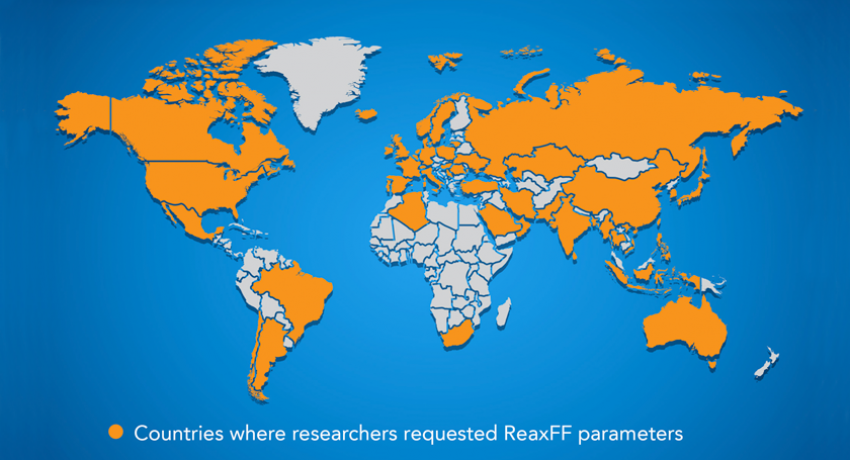The ReaxFF reactive force field has been requested by researchers in six of the seven world continents. Image: Elizabeth Floresgomez Murray/Penn State MRI
By Jamie Oberdick
More than 1,600 researchers in six of the world’s seven continents have requested parameters for a ReaxFF reactive force field developed by a Penn State researcher and used as a valuable research tool in fields as varied as biomaterials, polymers, batteries, and 3D printing.
While many may think of a force field as an invisible barrier made of energy in science fiction, in this case, a force field is a set of parameters and equations used to compute forces between atoms and molecules. ReaxFF is a bond order-based force field method and is a powerful computational tool that enables reactive simulations on complex materials such as one-atom-thick 2D materials. The ReaxFF method was invented by Adri van Duin, Penn State distinguished professor of mechanical engineering, while working at the University of Newcastle upon Tyne (UK) and in Bill Goddard’s group at the California Institute of Technology.
“They're used for so-called molecular dynamics simulations, which essentially means that we can follow what the motion of atoms do as a function of time,” said van Duin. “But one thing that is unique in them is you can make and break chemical bonds during those simulations.”
Through ReaxFF, researchers can gain extensive knowledge right down to the nanoscale of the material they are investigating, enabling them to optimize these materials and develop new material concepts. It is cost-effective and more efficient than quantum mechanics, which are more accurate and more transferable but much more computationally intensive.
Researchers have used ReaxFF for many different types of research. Van Duin and his team have used it as part of research to improve 3D printing. Given its effectiveness with 2D materials, it has also been used for developing artificial membranes for better fuel cells and water filtering and desalination techniques.
"We have a very good parameter set for many types of water-based chemistry and that's clearly something that that comes back in many different applications,” van Duin said.
Outside of Penn State, it has been used to understand why silver tarnishes. Other examples are several projects with the Oak Ridge National Laboratory and a project with the University of Virginia involving carbon fiber synthesis, which is converting polymers into carbon fibers.
“One interesting aspect is how we can connect ReaxFF to other simulation methods,” van Duin said. "For example, recently I've been working with Yuan Xuan, associate professor in mechanical engineering, who performs computational fluid dynamics simulations. By using ReaxFF he can give his group real-time reaction dynamics information that they can put into his research tools, and he can then really simulate an entire reactor. We can give him the constraints that he needs to actually simulate the actual fuel reactor conditions.”
The parameters can even be used in biological-type applications, such as biopolymer materials, natural polymers produced by living cells, like cellulose, starch, and proteins.
"The ReaxFF method is especially good for people that want to simulate how of biopolymers interact with inorganic surfaces,” van Duin said. “These are quite convenient for them to work with, because they handle that interface quite well.”
As more people, both nationally and internationally, used the parameters, researchers are adjusting the ReaxFF parameters for their own use.
“I found out about groups all around the world that actually independently developed force field parameters and start their own kind of application domains,” van Duin said. “So right now, there're often in any given week probably five to 10 publications associated with these particular methods. Even though I try to stay on top of that literature, I have a hard time keeping track of what everybody is doing with ReaxFF these days.”
Those interested can acquire the parameters for the ReaxFF by emailing van Duin’s group to request it.
"Typically, it can be a bit of an email exchange where we discuss, okay, what exactly do we want to simulate?” van Duin said. “And I tell them: these parameters had may be useful, or maybe even something that is exactly what they need, or something that may get close to what they need. In the latter case we tell them to try the simulations, don't do anything large scale yet, but just test it out and see if you see the right things, if it looks promising, you can scale it up.”
Sometimes van Duin will receive a request for a reactive force field they cannot offer. If the magnitude of the request is scalable, van Duin sees it as an opportunity.
"This can be an occasion that has led to projects in my group, perhaps the graduate students in my group can work with them to put a force field together,” van Duin said.
While the more than 1,600 requests for the ReaxFF parameters are certainly impressive, van Duin is exploring ways to expand access for even more requests. As a faculty researcher in the Materials Research Institute’s Two-Dimensional Crystal Consortium (2DCC), he is exploring ways to incorporate 2DCC resources to meet requests.
"We want to see if we can kind of improve the user experience by connecting it to the 2DCC extension program, especially for the 2D material-related request,” van Duin said. “We can make this entire concept more user friendly, and also, indeed have an automatic way that when people say, 'the parameter set I need doesn't exist,’ and in some way can that automatically be turned into an external user request and then that becomes an active project form my group.”
More information and how to obtain ReaxFF parameters can be found at https://www.engr.psu.edu/adri/Home.aspx.

